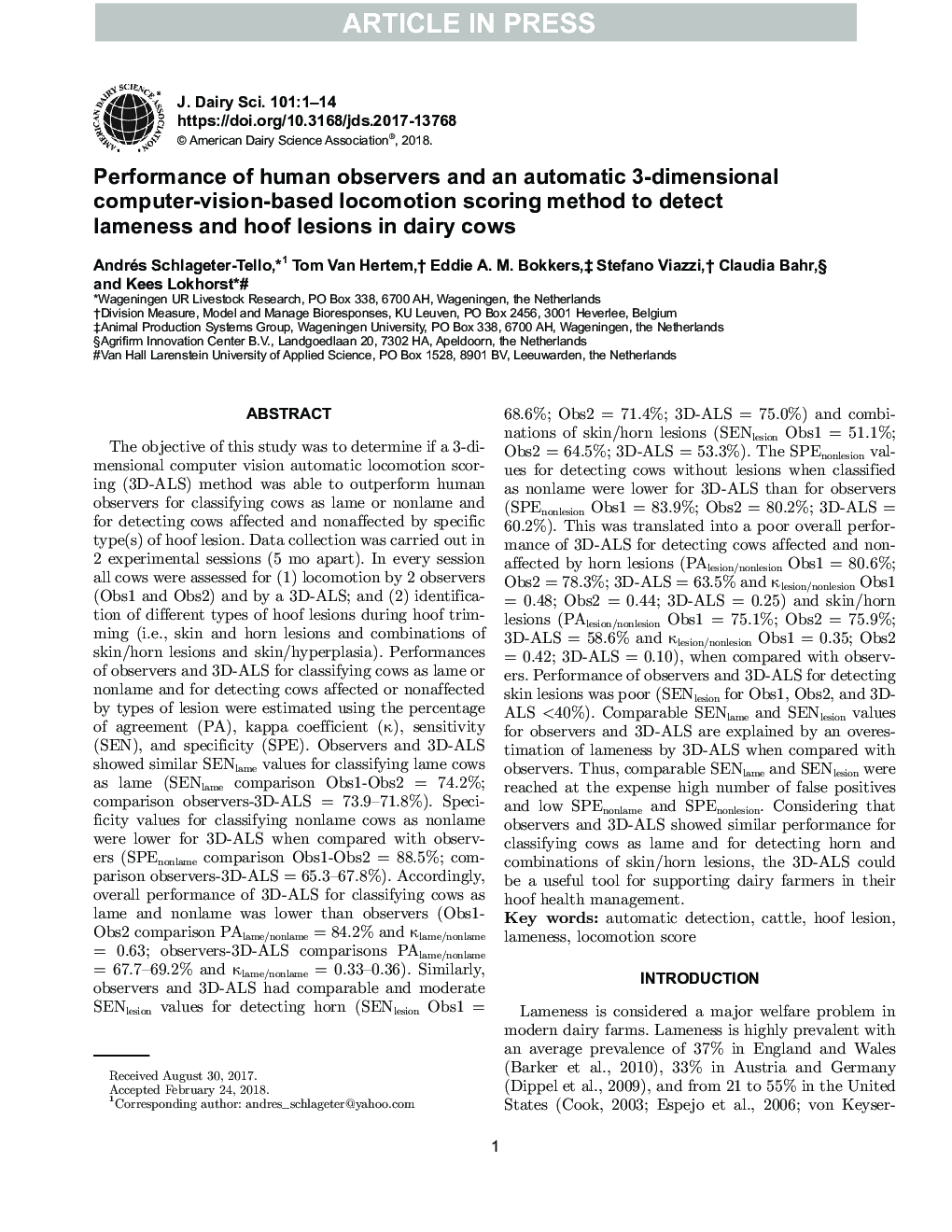| کد مقاله | کد نشریه | سال انتشار | مقاله انگلیسی | نسخه تمام متن |
|---|---|---|---|---|
| 8501043 | 1553838 | 2018 | 14 صفحه PDF | دانلود رایگان |
عنوان انگلیسی مقاله ISI
Performance of human observers and an automatic 3-dimensional computer-vision-based locomotion scoring method to detect lameness and hoof lesions in dairy cows
ترجمه فارسی عنوان
عملکرد ناظران انسانی و یک روش نمره دهی متحرک به صورت اتوماتیک 3 بعدی کامپیوتری جهت تشخیص لنگر و ضایعات گوسفند در گاوهای شیری
دانلود مقاله + سفارش ترجمه
دانلود مقاله ISI انگلیسی
رایگان برای ایرانیان
کلمات کلیدی
تشخیص خودکار، گاو ضایعه گوسفند، لنگش نمره حرکت
موضوعات مرتبط
علوم زیستی و بیوفناوری
علوم کشاورزی و بیولوژیک
علوم دامی و جانورشناسی
چکیده انگلیسی
The objective of this study was to determine if a 3-dimensional computer vision automatic locomotion scoring (3D-ALS) method was able to outperform human observers for classifying cows as lame or nonlame and for detecting cows affected and nonaffected by specific type(s) of hoof lesion. Data collection was carried out in 2 experimental sessions (5 mo apart). In every session all cows were assessed for (1) locomotion by 2 observers (Obs1 and Obs2) and by a 3D-ALS; and (2) identification of different types of hoof lesions during hoof trimming (i.e., skin and horn lesions and combinations of skin/horn lesions and skin/hyperplasia). Performances of observers and 3D-ALS for classifying cows as lame or nonlame and for detecting cows affected or nonaffected by types of lesion were estimated using the percentage of agreement (PA), kappa coefficient (κ), sensitivity (SEN), and specificity (SPE). Observers and 3D-ALS showed similar SENlame values for classifying lame cows as lame (SENlame comparison Obs1-Obs2 = 74.2%; comparison observers-3D-ALS = 73.9-71.8%). Specificity values for classifying nonlame cows as nonlame were lower for 3D-ALS when compared with observers (SPEnonlame comparison Obs1-Obs2 = 88.5%; comparison observers-3D-ALS = 65.3-67.8%). Accordingly, overall performance of 3D-ALS for classifying cows as lame and nonlame was lower than observers (Obs1-Obs2 comparison PAlame/nonlame = 84.2% and κlame/nonlame = 0.63; observers-3D-ALS comparisons PAlame/nonlame = 67.7-69.2% and κlame/nonlame = 0.33-0.36). Similarly, observers and 3D-ALS had comparable and moderate SENlesion values for detecting horn (SENlesion Obs1 = 68.6%; Obs2 = 71.4%; 3D-ALS = 75.0%) and combinations of skin/horn lesions (SENlesion Obs1 = 51.1%; Obs2 = 64.5%; 3D-ALS = 53.3%). The SPEnonlesion values for detecting cows without lesions when classified as nonlame were lower for 3D-ALS than for observers (SPEnonlesion Obs1 = 83.9%; Obs2 = 80.2%; 3D-ALS = 60.2%). This was translated into a poor overall performance of 3D-ALS for detecting cows affected and nonaffected by horn lesions (PAlesion/nonlesion Obs1 = 80.6%; Obs2 = 78.3%; 3D-ALS = 63.5% and κlesion/nonlesion Obs1 = 0.48; Obs2 = 0.44; 3D-ALS = 0.25) and skin/horn lesions (PAlesion/nonlesion Obs1 = 75.1%; Obs2 = 75.9%; 3D-ALS = 58.6% and κlesion/nonlesion Obs1 = 0.35; Obs2 = 0.42; 3D-ALS = 0.10), when compared with observers. Performance of observers and 3D-ALS for detecting skin lesions was poor (SENlesion for Obs1, Obs2, and 3D-ALS <40%). Comparable SENlame and SENlesion values for observers and 3D-ALS are explained by an overestimation of lameness by 3D-ALS when compared with observers. Thus, comparable SENlame and SENlesion were reached at the expense high number of false positives and low SPEnonlame and SPEnonlesion. Considering that observers and 3D-ALS showed similar performance for classifying cows as lame and for detecting horn and combinations of skin/horn lesions, the 3D-ALS could be a useful tool for supporting dairy farmers in their hoof health management.
ناشر
Database: Elsevier - ScienceDirect (ساینس دایرکت)
Journal: Journal of Dairy Science - Volume 101, Issue 7, July 2018, Pages 6322-6335
Journal: Journal of Dairy Science - Volume 101, Issue 7, July 2018, Pages 6322-6335
نویسندگان
Andrés Schlageter-Tello, Tom Van Hertem, Eddie A.M. Bokkers, Stefano Viazzi, Claudia Bahr, Kees Lokhorst,
